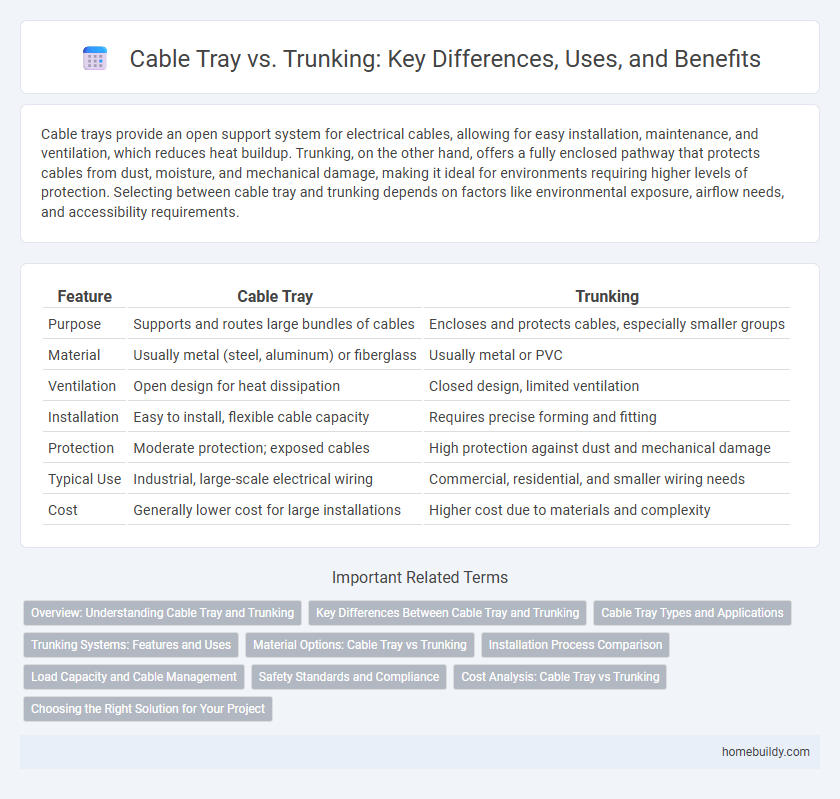Cable trays provide an open support system for electrical cables, allowing for easy installation, maintenance, and ventilation, which reduces heat buildup. Trunking, on the other hand, offers a fully enclosed pathway that protects cables from dust, moisture, and mechanical damage, making it ideal for environments requiring higher levels of protection. Selecting between cable tray and trunking depends on factors like environmental exposure, airflow needs, and accessibility requirements.
Table of Comparison
| Feature | Cable Tray | Trunking |
|---|---|---|
| Purpose | Supports and routes large bundles of cables | Encloses and protects cables, especially smaller groups |
| Material | Usually metal (steel, aluminum) or fiberglass | Usually metal or PVC |
| Ventilation | Open design for heat dissipation | Closed design, limited ventilation |
| Installation | Easy to install, flexible cable capacity | Requires precise forming and fitting |
| Protection | Moderate protection; exposed cables | High protection against dust and mechanical damage |
| Typical Use | Industrial, large-scale electrical wiring | Commercial, residential, and smaller wiring needs |
| Cost | Generally lower cost for large installations | Higher cost due to materials and complexity |
Overview: Understanding Cable Tray and Trunking
Cable trays are open or ladder-like structures designed to support and organize electrical cables, providing easy access for maintenance and modifications, while trunking consists of enclosed channels that protect cables from external damage and ensure a neat installation. Cable trays are ideal for environments requiring frequent cable changes or large volumes of wiring, whereas trunking suits installations needing enhanced protection and a cleaner aesthetic. Choosing between cable tray and trunking depends on factors such as installation site, cable type, environmental conditions, and maintenance requirements.
Key Differences Between Cable Tray and Trunking
Cable trays are open structures designed for supporting and routing electrical cables, allowing for better ventilation and easier cable maintenance. Trunking consists of enclosed, rigid channels that provide complete protection against dust, moisture, and physical damage, ideal for sensitive or exposed installations. The primary difference lies in ventilation and protection: cable trays offer ease of access and cooling, while trunking ensures comprehensive environmental shielding.
Cable Tray Types and Applications
Cable trays come in various types such as ladder, perforated, and solid-bottom, each suited for different load capacities and environmental conditions. Ladder trays are ideal for heavy-duty cables and industrial settings, while perforated trays provide better ventilation for minimizing heat buildup in electrical wiring. Solid-bottom trays offer superior protection against dust and moisture, making them suitable for sensitive or hazardous environments.
Trunking Systems: Features and Uses
Trunking systems offer robust protection for electrical cables through enclosed, rigid pathways, making them ideal for environments requiring high durability and security, such as industrial or commercial buildings. They facilitate organized cable management, reduce electromagnetic interference, and support easy access for maintenance and future wiring expansions. Unlike cable trays, trunking systems provide superior shielding and aesthetic integration within finished spaces, enhancing both safety and appearance.
Material Options: Cable Tray vs Trunking
Cable trays commonly use materials such as steel, stainless steel, aluminum, and fiberglass, offering excellent strength, corrosion resistance, and lightweight properties suited for various environments. Trunking systems are typically constructed from steel or PVC, emphasizing protection, electrical insulation, and ease of installation in indoor settings. Choosing between cable trays and trunking often depends on the specific material benefits aligned with environmental exposure and mechanical requirements.
Installation Process Comparison
Cable tray installation involves securing prefabricated metal or fiberglass trays to walls or ceilings, allowing for flexible cable management with open access for easy maintenance and future cable additions. Trunking requires fitting rigid, enclosed conduits that often demand precise measurements, cutting, and snapping or screwing joints together to provide complete cable protection. The cable tray method generally offers faster installation and better ventilation, while trunking demands more detailed assembly but ensures enclosed pathways for sensitive or exposed wiring environments.
Load Capacity and Cable Management
Cable trays generally offer higher load capacity compared to trunking, making them suitable for supporting heavy or large bundles of cables in industrial and commercial settings. Their open design facilitates superior cable management by allowing easy access for installation, inspection, and maintenance, while trunking's enclosed structure offers more limited space and flexibility. For complex cabling systems requiring frequent adjustments or expansions, cable trays provide a more efficient and scalable solution.
Safety Standards and Compliance
Cable trays comply with rigorous safety standards such as UL 568 and IEC 61537, ensuring fire resistance and load-bearing capacity for secure cable management. Trunking systems adhere to standards like BS EN 50085, providing robust protection against mechanical damage and electrical hazards. Both solutions must meet regional electrical codes, but cable trays often offer superior ventilation and ease of inspection, enhancing overall safety compliance.
Cost Analysis: Cable Tray vs Trunking
Cable trays generally offer a lower initial installation cost compared to trunking due to simpler design and faster assembly, especially in large-scale projects. Maintenance expenses for cable trays tend to be reduced since they allow easier access for inspections and modifications. However, trunking can sometimes provide better protection against environmental factors, potentially reducing long-term repair costs in harsh conditions.
Choosing the Right Solution for Your Project
Cable trays offer superior ventilation and easier access for maintenance compared to trunking, making them ideal for projects requiring frequent cable management and upgrades. Trunking provides a more enclosed solution, offering better mechanical protection and a cleaner aesthetic, suitable for environments where cables need to be hidden or shielded from external damage. Evaluating factors such as installation complexity, environmental exposure, and future scalability ensures selecting the most efficient and cost-effective method for cable organization.
Cable tray vs trunking Infographic

 homebuildy.com
homebuildy.com